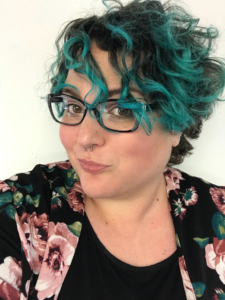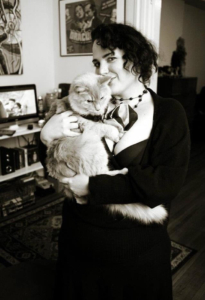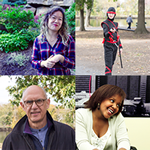Faces Behind the Screen: Rachel Melton
Quick Links
“I think the very simple fact of going to go see a play, looking at a piece of artwork, people make the assumption that, well, they can’t see it, so they don’t need it. That’s it. That’s the end of the story. Why would they care? They can’t see it.
And of course, they care. Because art and culture shapes our society. It shapes who we are. And especially for someone who loses their vision later in life, their connection with color, with certain pieces of art, are still just as strong — and maybe sometimes more so– once they’ve lost their vision. And I think, just the assumption that, why would a blind person even go to a play– well, to enjoy it, and to experience it just like you.
Yea, they’re not going to experience it exactly the way you are. But no one experiences everything exactly the same way as someone else. And one of the things that we really talk about with our audio description services, here at MindsEye, is that the idea of what we’re doing when we’re going in, and we’re providing those descriptive elements for a piece of artwork that you can’t touch, that’s behind some glass — and that’s the only way you can experience it, you think, is by staring at it.
Well, we can still provide those elements of the content of that context of the thickness of the paint or even what kind of medium it is, plus the history of the painter. There’s so much that you can actually describe about one still image, let alone, an entire production, play or a video.
And what that does is, it means that that person who wasn’t able to just go to the museum with their friends and family before, can now go and have those shared experiences and have those conversations and have those opinions about art and culture and enjoy it. They can absolutely enjoy it just as much as a sighted person.”
“I am the community outreach coordinator for MindsEye. MindsEye was founded about 45 years ago, as a radio reading service for the visually impaired and blind – or the print-impaired community. Starting back, they just started reading local and national print publications to be broadcast over a 24-hour radio station. And we still do that today. That’s definitely the main focus of what we do as an organization.
More recently, we started providing audio description services for the community as well. Audio description, for those who aren’t that familiar with it, creates accessibility for those with visual impairments to connect more with the artwork or the theatrical elements of a show or even going to the zoo, etc., so that they can experience those right alongside their friends and family. Our mission at MindsEye is, very simply, to translate vision into audio. We try to commit to doing that, now, not only through our radio broadcast but through our audio description services, which have taken off.
We’ve been able to connect with many theaters here in the St. Louis region as well as the St. Louis Zoo and the Missouri History Museum and small organizations for events, etc., any individual or organization that wants to make sure that what they’re creating is going to be accessible for those with visual impairments.
My work through MindsEye is very much talking to the community about what we do and coordinating our describers with their plays or with an exhibit or tour. The majority of our description services, right now, are through theaters, so we do focus on mostly live description. However, we do provide video description as well. A lot of our community partners, when they do social media videos and stuff, and they want to make sure that it’s accessible for the whole community, they’ll reach out to us, and we’ve started doing that as well.
It’s a very new program for us. As I said, it was founded in the fall of 2016. So we had the goal of reaching– I want to say we wanted to do, like, 20 to 30 shows our first year or events. And we did over 60. So the need is there.”
As a whole, there’s this idea of accessibility being– people get stuck on the idea of wheelchairs. Like, let me make sure we have ramps. We need to make sure that people can get into a building. But once you get into the building, you need to make sure that those programs [and content] are accessible as well.
And how do you make those programs accessible and also accessible for people that do have other physical disabilities – making sure that the exhibits are at a certain height so that they’re not too high? If they have to read things then maybe the print is bigger or you have audio elements.
I think, as a whole, everyone sort of moving in the direction of realizing that accessibility, not only benefits those with disabilities but also our entire community. Sometimes people don’t want to mention that they’re hard of hearing and that the print is too small or something, but by just doing these basic things, we’re actually making sure that everyone is more connected.
I don’t know about the rest of the world. But I think, for audio descriptions, specifically, I know that England and Canada are definitely a little bit farther ahead [than the US] on making those services a standard. Where, in the US, closed captioning has been part of TV and movies, my entire life. I’ve always been aware of what closed captioning was.
And now audio description is becoming much more available. And people are actually learning about it through just the fact that they can go on Netflix, and that’s one of the options that they can choose for about 40% of their movies. Where before, it just wasn’t talked about. It wasn’t even a thought for most people.
Faces Behind the Screen is a storytelling project focusing on communities that benefit from a more accessible web.






